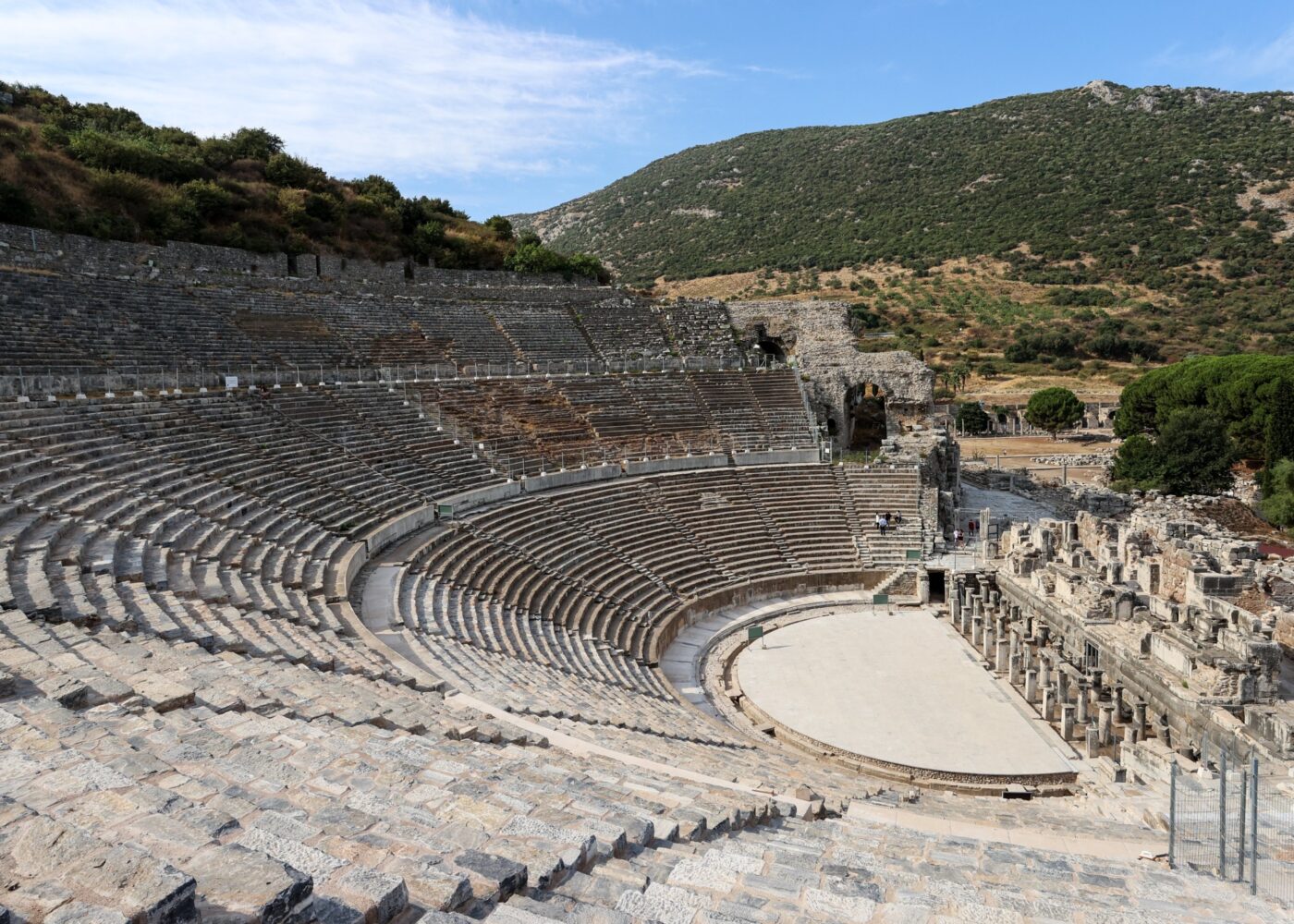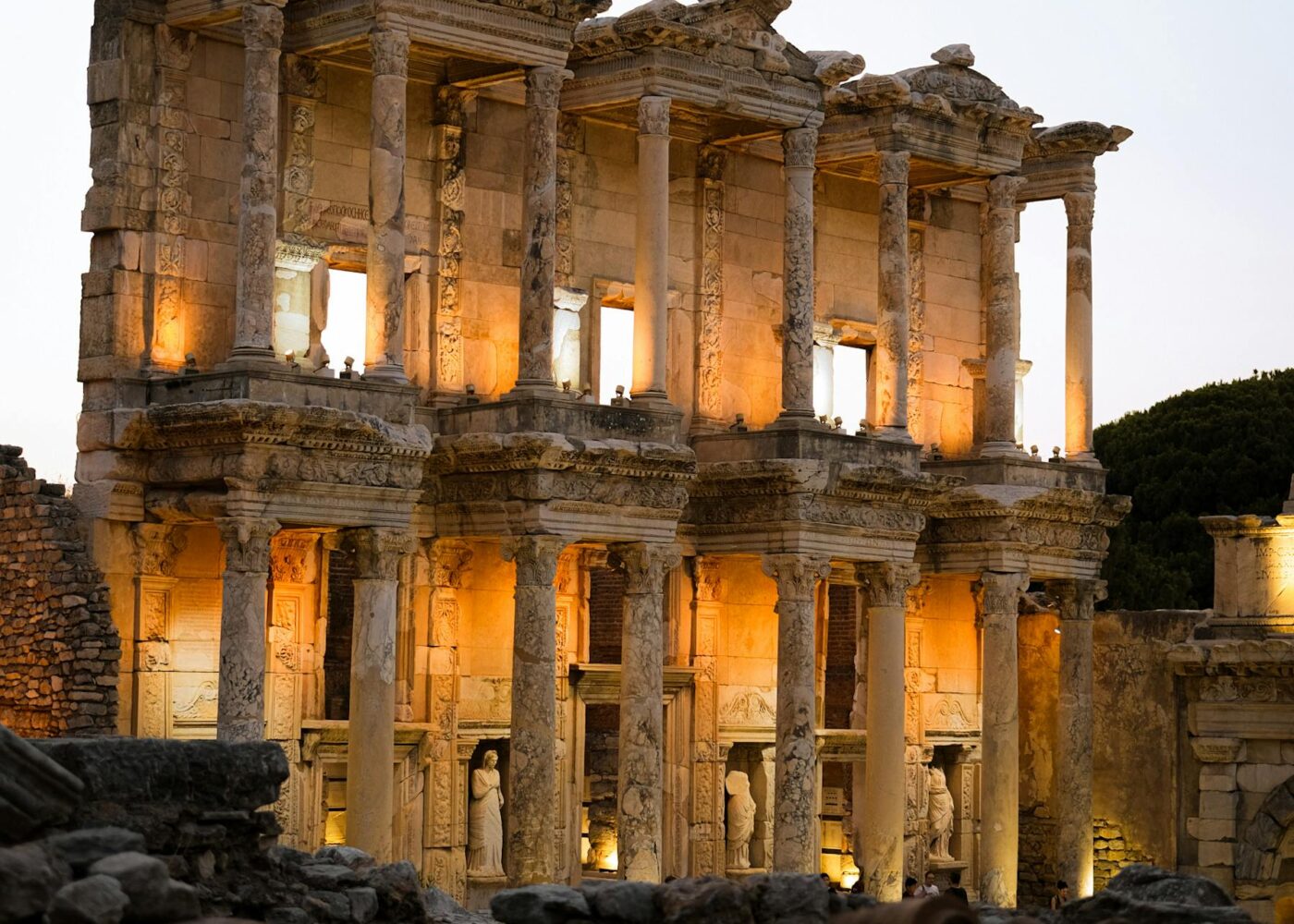Ephesus Ancient City

Ephesus Ancient City is one of the prominent ancient cities of the world. The Temple of Artemis, one of the seven wonders of the world, is located in Ephesus. The city is made of marble and has the high reputation of being one of the best planned cities in the history of humanity. Every step you will take in Ephesus invites you to a unique experience of rich history. The Odeon, King’s Way, Church of Mary and the fabled Celsus Library are only some of the ancient wonders you are going to encounter in Ephesus. Summer, between May and September, is the ideal time for visiting Ephesus.
Ancient Splendour
It is believed that Ephesus was founded by the Amazons, the warrior women of Bronze Age Anatolia. The original name of the city was Apasas which meant “The City of the Great Goddess”. Ephesus has always been a central hub of trade, culture and all social contact throughout the centuries.
Located between the East and the West, Ephesus was a prominent port city through time. The Hellenistic, Roman, Byzantine and Ottoman eras came and passed, yet Ephesus is still standing. It was the capital of Asia during Roman times and was regarded as one of the four greatest cities of the world with its population of 250 thousand.
Ephesus had to be moved a little due to natural causes during the Byzantine and Seljuk eras.
Ephesus is recorded in the UNESCO World Heritage Sites list since 2015 with its many features such as the Çukuriçi Mound, İsa Bey Mosque, İsa Bey Roman Bath, Artemision, St. John Basilica, Seljuk Castle, Ephesus Ancient City, Mother Mary’s House.

Places of Visit
Ephesus has hosted many civilisations throughout the centuries and acted as a cultural and economical hub. Ephesus is crowned with a diverse abundance of religions from Goddess worship to paganism, Christianity and Islam. Hence the city is adorned with fabled works of art and architecture:
The Temple of Artemis (Artemision)
The Lydian King Croesus ordered the Temple of Artemis in 550 BCE for the Goddess Artemis. The Temple of Artemis is the first temple of antiquity made of marble. It is said that the temple had burnt down on the night when Alexander the Great was born. It was remade yet plundered in 263 CE. Afterwards the materials of the temple were used in other buildings. It is estimated that the temple was 125 meters long and 65 meters wide. Unfortunately today we have so little left of the temple, yet even what is left helps us to imagine the days of the Artemision’s glory.
Antipader of Sidon describes the The Temple of Artemis in awe in this Seven Wonders:
“I have set eyes on the wall of lofty Babylon on which is a road for chariots, and the statue of Zeus by the Alpheus, and the hanging gardens, and the colossus of the Sun, and the huge labour of the high pyramids, and the vast tomb of Mausolus; but when I saw the house of Artemis that mounted to the clouds, those other marvels lost their brilliancy, and I said, “Lo, apart from Olympus, the Sun never looked on aught so grand.”

The Library of Celsus
The Library of Celsus was ordered to be built as a mausoleum for Celcus Polamaeanus, who was the governor of Anatolia. This library, which is also the mausoleum of Celcus, is built with Roman architecture. At the front side of the library you will see statues of three goddesses who are: Arete, Episteme and Sophia. The ones you see in Ephesus are the beautiful copies of the original statues which are displayed in Wien, in Austria.
The Library of Celsus was one of the richest libraries of the era. It is estimated to have more than fourteen thousand books.
Great Theatre

The Great Theatre which was built by the Emperor Claudius in the Hellenistic era is the largest open air theatre in the world. This theatre was used for plays, gladiators, symposiums, festivals as well as St. Paul’s sermons. In modern times, the most famous orchestra of the world has also performed in Ephesus. It was designed to host twenty-four thousand people. Even though the three-storey building has been demolished, the remaining parts endured.
Do you remember the symbol of theatre, the two faces, one laughing and one crying ? Our Great Theatre is the place this symbol was invented. These masks were used in the Dionysian festivals, obscuring the identities of the actors who were to make political and offensive performances.
The Church of Virgin Mary in Ephesus
The Church of Virgin Mary is one of the first seven churches of Christianity.
There is a very interesting story in the history of The Church of Virgin Mary. Towards the end of the Nineteenth Century, a German nun named Katharina Emmerick, who had never travelled outside her own village, one day gets seriously sick and begins to talk about the places far far away, she had not heard of before. The author Clemens Brentano, records everything Emmerick says and writes a book about the Virgin Mary. When this book reaches İzmir in 1891, the listeners feel a great curiosity. A group of people set off to look for the church mentioned in this book and find the Church of Virgin Mary. Ever since, this church has become a focal point for Christianity.
Seven Sleepers
The Legend of the Seven Sleepers is widespread. There are many caves atoned to the Seven Sleepers around the world: four in Turkey and three hundred around the world. However, a great number of Christian literature points at the cave in Ephesus as the Seven Sleepers’ cave. Therefore the cave near Ephesus is prominent.
Seven Christians hide in these sarcophagi hidden inside a cave, escaping persecution. These young people are put to sleep for 300 years and when they wake up, Christianity is already an accepted religion and they can live freely. According to another version, the current pagan ruler of the land learns where the Seven Sleepers hide and seals the entrance of the cave as well as putting a sign on it indicating that there are people inside this cave who are being punished by him. Following the captivity of 200 years, the cave is opened by the farmers. The Seven Sleepers meet the daylight, leave their cave and rejoin the society.
Activities in Ephesus
Ephesus is also rich with local and seasonal activities.
- Selçuk Ephesus Festival
Selçuk Ephesus Festival is held every year in September. There are many cultural and artistic activities such as theatre plays, concerts and fun for children.
- Mother Mary Ritual Service
Every year on 15 August, The Church of Virgin Mary hosts religious rituals and services attended by representatives from the Vatican.

Where to Stay in Ephesus?
Ephesus Ancient City is under strict rules of preservation. Therefore you can find rich and varied accommodation options in neighboring areas such as Selçuk, Kusadasi and İzmir.
Things to Know About Ephesus
- Ephesus is the only great city which preserves its form from Late Antiquity and Rome periods.
- Water used to be carried to Ephesus via viaducts.
- All streets cut each other at right angles.
- The Ancient City of Ephesus is open to visitors every day of the week between 08.00-19.00 in the summer months and between 08.00-17.00 in the winter months.
- During your visit to Ephesus you can visit Şirince, the most beautiful village of the Aegean, taste its fabled gözleme and delicate wines.

